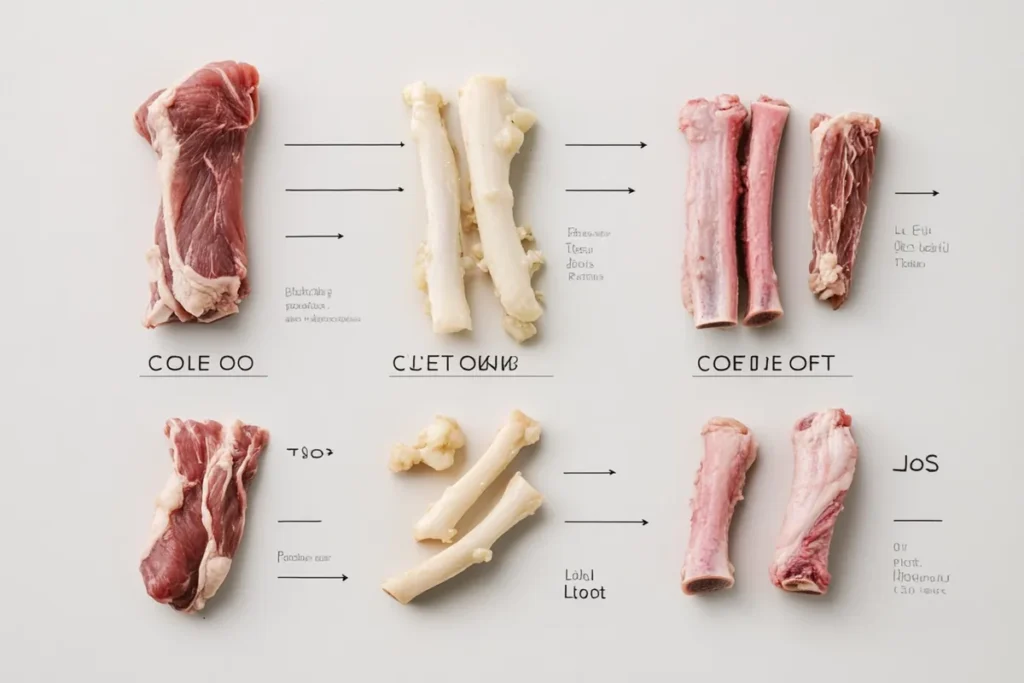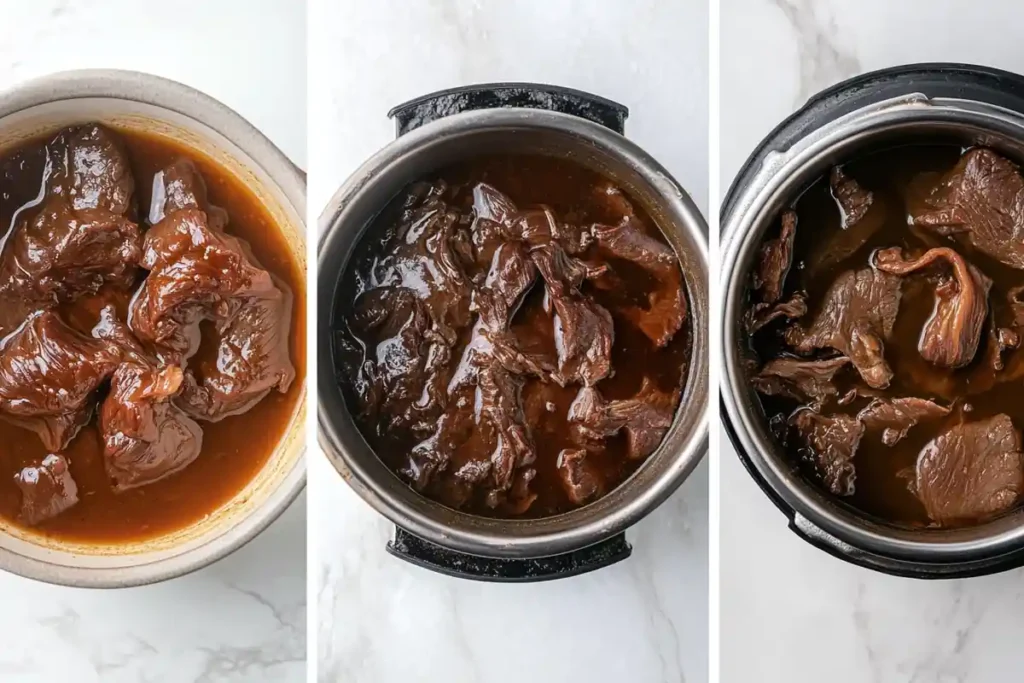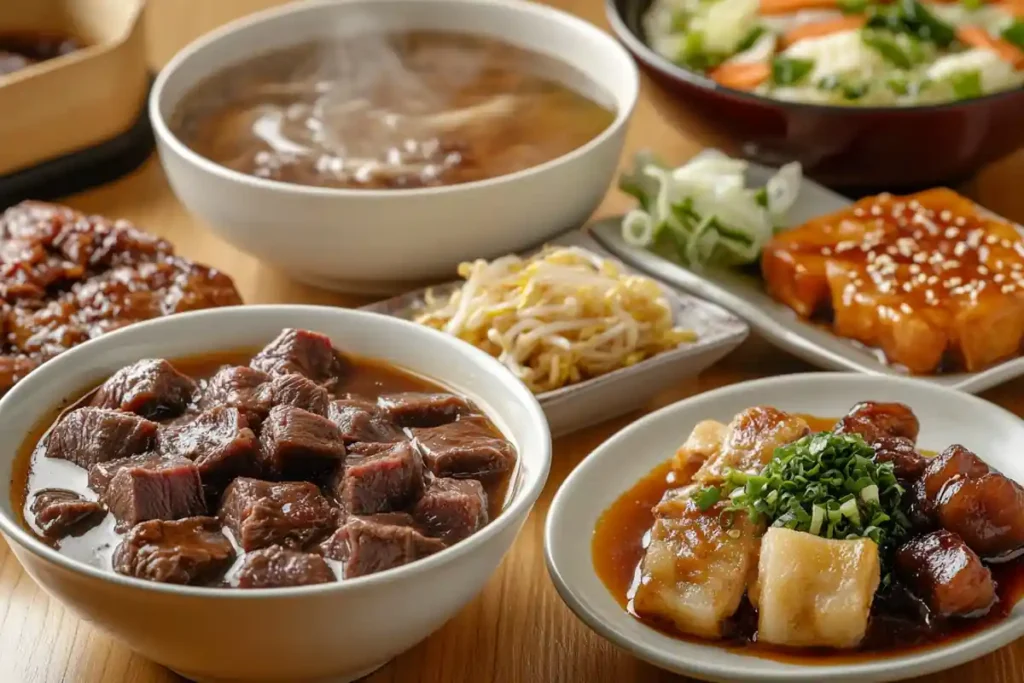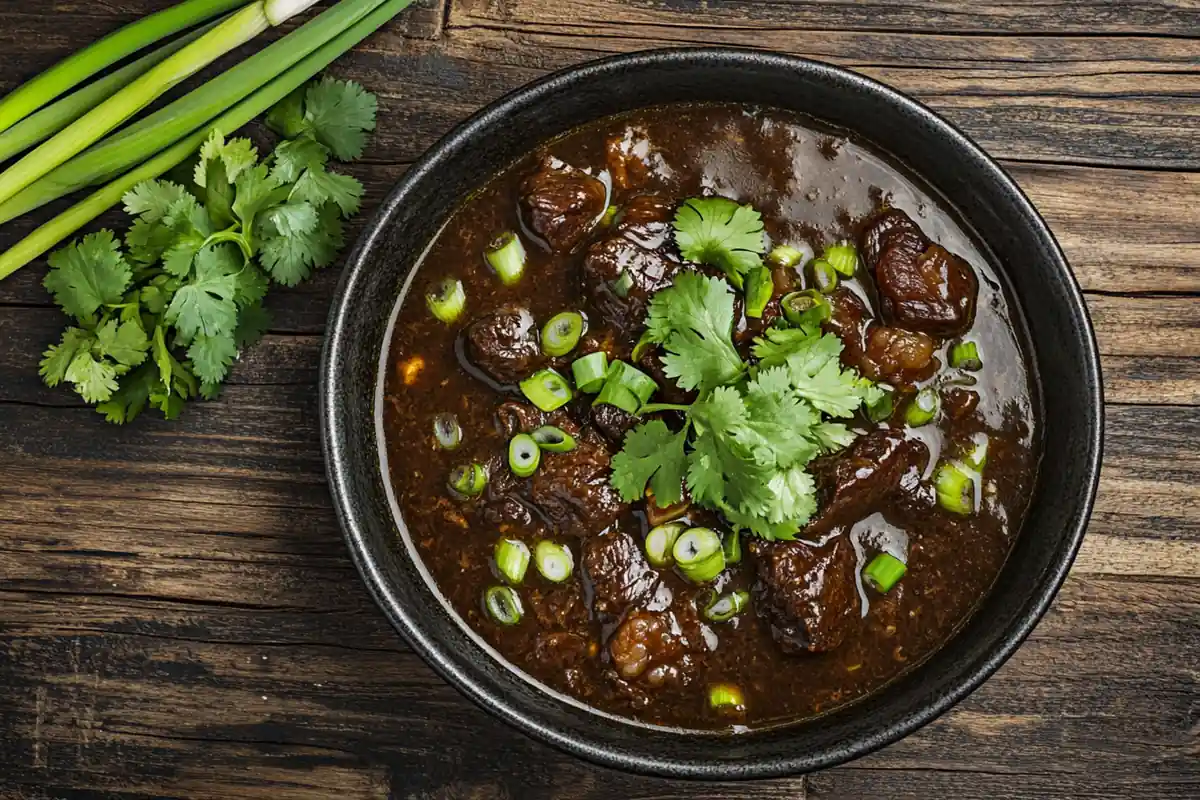Beef tendon is a hidden gem in the culinary world. This collagen-rich connective tissue is a staple in many Asian cuisines, yet it remains underappreciated in Western kitchens. Packed with protein and low in fat, it offers not just a unique gelatinous texture but also incredible health benefits.
From its role in traditional dishes like Vietnamese pho to its increasing popularity in modern recipes, collagen rich meat is gaining recognition as a nutritional powerhouse. If you’ve ever wondered about its health benefits, how to cook it properly, or how it enhances various dishes, you’re in the right place.
Table of Contents
Introduction
What is Beef Tendon?
Beef tendon is a fibrous connective tissue that attaches muscle to bone in cattle. When cooked properly, it becomes soft, gelatinous, and flavorful, making it a highly prized ingredient in many Asian cuisines.
Why is Beef Tendon Special?
- Rich in collagen: Supports skin, joints, and overall health.
- Absorbs flavors well: Perfect for slow-cooked dishes.
- Low in fat, high in protein: A nutritious addition to any diet.
Nutritional Profile of Slow-cooked Tendon
| Nutrient | Benefit |
|---|---|
| Collagen | Improves skin and joint health |
| Protein | Supports muscle repair and growth |
| Iron | Boosts oxygen circulation |
| Glycine | Aids digestion and reduces inflammation |

Culinary Significance of Beef Tendon
In Chinese, Vietnamese, Japanese, and Thai cuisines, collagen rich meat is used in soups, braised dishes, and stews for its silky texture and deep umami flavor. Whether slow-cooked in pho or braised in soy sauce, it’s a delicious and nutritious ingredient worth trying!
Health Benefits of Consuming Beef Tendon
Why is Beef Tendon Good for You?
Collagen rich meat isn’t just tasty it’s a nutrient-dense superfood packed with collagen, protein, and essential amino acids. It supports joint health, skin elasticity, and digestion, making it a great addition to a balanced diet.
Top Health Benefits
1. Rich Source of Collagen
- Strengthens joints and bones: Helps prevent arthritis and joint pain.
- Boosts skin health: Reduces wrinkles and improves hydration.
- Aids digestion: Strengthens the gut lining and supports healthy digestion.
2. High in Protein, Low in Fat
- Builds and repairs muscles: Ideal for fitness and recovery.
- Low in calories: A great lean meat option for weight management.
- Satiating and nutrient-dense: Keeps you full without excess fat.
3. Supports Joint and Bone Health
- Helps repair cartilage: Reduces stiffness and enhances mobility.
- Rich in glycine and proline: Essential amino acids for connective tissues.
- Perfect for aging individuals or athletes: Maintains flexibility and movement.
Beef Tendon and Gut Health
Since it’s high in gelatin, beef tendon helps:
- Improve gut lining health: Beneficial for people with digestive issues.
- Reduce inflammation: Supports overall well-being.
- Promote a balanced microbiome: Aids digestion and absorption of nutrients.
According to Healthline, collagen-rich foods like beef tendon can significantly improve skin, joint, and digestive health.stive health.
Culinary Uses of Beef Tendon
Why is Beef Tendon a Culinary Treasure?
Beef tendon is versatile, nutrient-rich, and absorbs flavors beautifully, making it a favorite in Asian cuisine. When cooked properly, it transforms from tough and fibrous to soft, gelatinous, and deeply flavorful.
Popular Dishes
- Vietnamese Pho: Sliced thin and added to broth for extra richness.
- Chinese Braised Beef Tendon: Slow-cooked in soy sauce, star anise, and ginger.
- Japanese Gyusuji Nikomi: A miso-based stew with beef tendon and vegetables.
- Thai Spicy Beef Tendon Soup: A bold and flavorful dish with chili and herbs.
Best Cooking Methods
1. Slow Cooking (Best for Stews & Soups)
- Breaks down collagen for a melt-in-your-mouth texture.
- Requires 6–8 hours on low heat for best results.
2. Pressure Cooking (Fastest Method)
- Reduces cooking time to 45–60 minutes.
- Retains flavor and nutrients while making it tender.
3. Braising (For Maximum Flavor Absorption)
- Infuses tendon with deep umami flavors.
- Cooks in a sauce for 3–4 hours until soft.
Beef tendon has little natural flavor, but its magic lies in its ability to absorb seasonings and enhance dishes!potential!
How to Prepare Beef Tendon at Home
Cooking beef tendon at home may seem challenging, but with the right techniques, you can achieve a soft, gelatinous, and flavorful result. The key is proper cleaning, preparation, and slow cooking to unlock its full potential.

Selecting the Best Beef Tendon
- Look for fresh, firm, and pale-white tendons: Avoid those that are overly dry or discolored.
- Opt for thick pieces: They hold their texture better during cooking.
- Check butcher shops or Asian markets: These are the best places to find high-quality beef tendon.
Cleaning and Prepping Beef Tendon
Since beef tendon contains excess fat and impurities, it’s crucial to clean it thoroughly before cooking.
How to Clean Beef Tendon
- Rinse under cold water to remove surface debris.
- Blanch in boiling water for 5–10 minutes to remove impurities.
- Drain and rinse again to ensure a clean taste.
- Trim any excess fat if necessary.
Blanching helps remove unwanted odors and creates a cleaner broth when cooking!
Best Cooking Methods
1. Slow Cooking (Best for Broths & Stews)
- Low heat for 6–8 hours results in tender, gelatinous beef tendon.
- Perfect for pho, soups, and braised dishes.
2. Pressure Cooking (Quick & Effective)
- Reduces cooking time to 45–60 minutes.
- Best for those who want quick yet tender beef tendon.
3. Braising (For Deep, Rich Flavor)
- Cooks in soy sauce, ginger, garlic, and star anise for 3–4 hours.
- Creates a savory and umami-packed dish.
Storing Cooked Beef Tendon
- Refrigerate for up to 5 days in an airtight container.
- Freeze for up to 3 months for later use.
- Reheat by simmering in broth or adding to soups and stir-fries.
Popular Beef Tendon Recipes
Now that we’ve covered how to prepare beef tendon, it’s time to cook! Whether you prefer slow-cooked, spicy, or rich umami flavors, there’s a beef tendon dish for you. These authentic and delicious recipes will help you enjoy beef tendon like a pro.
Let’s dive into some of the best ways to cook tender, flavorful beef tendon at home!
Braised Beef Tendon
This classic dish features beef tendon slow-cooked in a savory sauce until it becomes rich and gelatinous. Perfect for pairing with rice or noodles!
Ingredients:
- 2 lbs beef tendon, cleaned and cut into chunks
- 3 tbsp soy sauce
- 1 tbsp oyster sauce
- 1 tbsp dark soy sauce (for color)
- 4 cloves garlic, minced
- 1-inch ginger, sliced
- 2 star anise
- 1 cinnamon stick
- 1 tbsp sugar
- 4 cups beef broth or water
- 2 tbsp cooking oil
Instructions:
- Sear the tendon: Heat oil in a pot, add beef tendon, and brown slightly.
- Sauté aromatics: Add garlic, ginger, star anise, and cinnamon. Stir until fragrant.
- Add sauces: Pour in soy sauce, oyster sauce, and sugar. Stir to coat the tendons.
- Simmer: Add broth, bring to a boil, then lower heat and simmer for 3–4 hours.
- Serve: Once tender, serve over rice or noodles.
Pro Tip: For faster results, use a pressure cooker and cook for 45 minutes instead of slow simmering.
Spicy Sichuan Beef Tendon
If you love bold, spicy flavors, this dish is for you! Sichuan-style beef tendon is tossed in a chili-infused sauce with aromatic spices.
Ingredients:
- 1 lb beef tendon, boiled and sliced thin
- 2 tbsp Sichuan chili oil
- 1 tbsp soy sauce
- 1 tbsp black vinegar
- 2 cloves garlic, minced
- 1 tsp sesame oil
- 1 tsp sugar
- 1 tbsp roasted peanuts (for crunch)
- 1 tsp chopped green onions
Instructions:
- Slice the tendon: Once boiled and cooled, slice it into thin pieces.
- Mix the sauce: Combine chili oil, soy sauce, vinegar, garlic, sugar, and sesame oil.
- Toss the tendon: Mix the sliced tendon with the sauce until evenly coated.
- Garnish & serve: Top with chopped peanuts and green onions.
This dish is perfect as a cold appetizer or side dish!
Japanese Beef Tendon Stew (Gyusuji Nikomi)
A comforting Japanese-style beef tendon stew, simmered until thick, rich, and deeply flavorful.
Ingredients:
- 1.5 lbs beef tendon, cut into pieces
- 1 onion, sliced
- 2 tbsp soy sauce
- 2 tbsp miso paste
- 1 tbsp sake (optional)
- 1 tbsp sugar
- 1-inch ginger, grated
- 4 cups dashi broth
- 1 green onion, chopped (for garnish)
Instructions:
- Blanch the tendon: Boil for 10 minutes, then drain and rinse.
- Sauté aromatics: Cook onions and ginger in a pot until fragrant.
- Simmer: Add beef tendon, broth, soy sauce, miso, and sugar. Cook for 3 hours on low heat.
- Serve hot: Garnish with green onions and enjoy over rice.
For an extra umami kick, add mushrooms or daikon radish while simmering!
Beef Tendon in Vietnamese Pho
Beef tendon is a must-have in authentic Vietnamese pho. It adds depth, richness, and collagen to the flavorful broth.
How to Use Beef Tendon in Pho:
- Boil tendon for 3–4 hours until soft, then slice thin.
- Add to pho broth along with brisket and beef bones.
- Top with fresh herbs, lime, and chili for an authentic experience.
Cultural Perspectives
While beef tendon is a staple in Asian cuisine, it is slowly making its way into Western kitchens, thanks to its health benefits and unique texture. Across different cultures, it has been prized for centuries for its ability to enhance flavors, thicken soups naturally, and provide collagen-rich nourishment.
Beef Tendon in Asian Cuisines
In many Asian countries, collagen-rich meat is considered a delicacy. It is often cooked low and slow, allowing the collagen to break down into a gelatinous, melt-in-your-mouth texture.
How Different Asian Cultures Use Beef Tendon:
🇨🇳 China: Braised in soy sauce, star anise, and ginger for a deeply flavorful dish.
🇻🇳 Vietnam: Sliced thin and served in pho, enhancing the broth’s richness.
🇯🇵 Japan: Stewed in miso and soy sauce (Gyusuji Nikomi), often served with rice.
🇰🇷 Korea: Used in Gomtang, a clear beef soup known for its deep umami taste.
🇹🇭 Thailand: Added to spicy and sour soups for extra richness.
In many Asian households, beef tendon is seen as a superfood, often served to promote joint health and overall wellness.

Western Adoption
For years, collagen-rich meat was overlooked in Western cuisine. But as people become more aware of its health benefits and culinary versatility, it’s appearing on more high-end restaurant menus and in home kitchens.
Why Western Chefs Are Using More Beef Tendon:
- Trend Towards Nose-to-Tail Eating: More chefs are embracing whole-animal cooking, reducing waste and utilizing all parts of the cow.
- Health-Conscious Consumers: The rise in collagen-based diets has made beef tendon a sought-after superfood.
- Rich Texture for Broths & Sauces: Its gelatin-rich consistency helps thicken soups and gravies naturally.
- Fusion Cuisine Popularity: More chefs are experimenting with Asian-inspired dishes, introducing beef tendon into Western-style stews and appetizers.
Some Michelin-star restaurants now feature beef tendon in their broths, ramen, and slow-cooked delicacies!
Why Beef Tendon is a Culinary Gem Across Cultures
Regardless of where it’s used, beef tendon’s versatility makes it a valuable ingredient in many dishes. Its ability to absorb flavors, create deep, rich broths, and provide nutritional benefits ensures it will continue to gain popularity worldwide.
How to Incorporate Beef Tendon into Modern Dishes:
- Add it to homemade bone broth for extra richness.
- Use it in slow-cooked chili for a unique texture.
- Toss it in spicy stir-fries for a fusion-style dish.
- Combine it with beef cheeks or short ribs for tender, collagen-packed stews.
Frequently Asked Questions (FAQs)
If you’re new to collagen rich meat or just want to learn more about it, you probably have some questions. From its health benefits to cooking techniques, let’s dive into the most common questions people ask about this collagen-rich delicacy!
Is beef tendon healthy to eat?
Absolutely! gelatinous beef dish is packed with collagen, protein, and essential amino acids, making it an excellent choice for promoting:
- Joint health: Helps strengthen connective tissues.
- Skin elasticity: Reduces wrinkles and improves hydration.
- Muscle recovery: Provides amino acids for tissue repair.
- Gut health: Supports digestion and gut lining integrity.
It’s also low in fat, making it a lean and nutritious meat option.
How do you cook beef tendon properly?
Since beef tendon starts out tough and fibrous, it requires long, slow cooking to become soft and gelatinous.
- Slow cook for 6–8 hours for maximum tenderness.
- Pressure cook for 45 minutes if you’re short on time.
- Braise in flavorful sauces for a rich, umami-packed dish.
Where can I buy beef tendon?
You can find beef tendon at:
- Asian grocery stores (fresh or frozen).
- Local butcher shops (ask if they carry specialty cuts).
- Online meat suppliers (delivered fresh or frozen).
If you don’t see it in your local store, check with a specialty butcher or an Asian market.
What does beef tendon taste like?
Beef tendon itself has a mild, neutral flavor, but its real magic lies in its texture and ability to absorb seasonings.
- Gelatinous & slightly chewy when slow-cooked.
- Absorbs the flavors of broths, spices, and marinades.
- Adds depth to soups and stews without overpowering them.
Think of it as a texture-enhancer rather than a strongly flavored ingredient!
Can I freeze cooked beef tendon?
Yes! Beef tendon freezes well and can be stored for later use.
- Refrigerate for up to 5 days in an airtight container.
- Freeze for up to 3 months in a sealed bag or vacuum-packed pouch.
- Reheat by simmering in broth or adding directly to soups and stews.
Pro Tip: Freeze cooked tendon with some of its broth to prevent it from drying out.
Is beef tendon high in fat?
No! Despite its rich, gelatinous texture, beef connective tissue is actually low in fat. Most of its calories come from collagen protein, making it an excellent lean meat alternative.
- Low in saturated fat.
- High in protein and amino acids.
- Perfect for high-protein, low-fat diets.
Final Thoughts
Beef tendon may not be as common as steak or ribs, but its health benefits, unique texture, and culinary versatility make it a hidden gem in the kitchen. Whether you’re a foodie, an athlete, or just someone looking to try new, exciting dishes, gelatinous beef dish is definitely worth a spot in your cooking routine!

